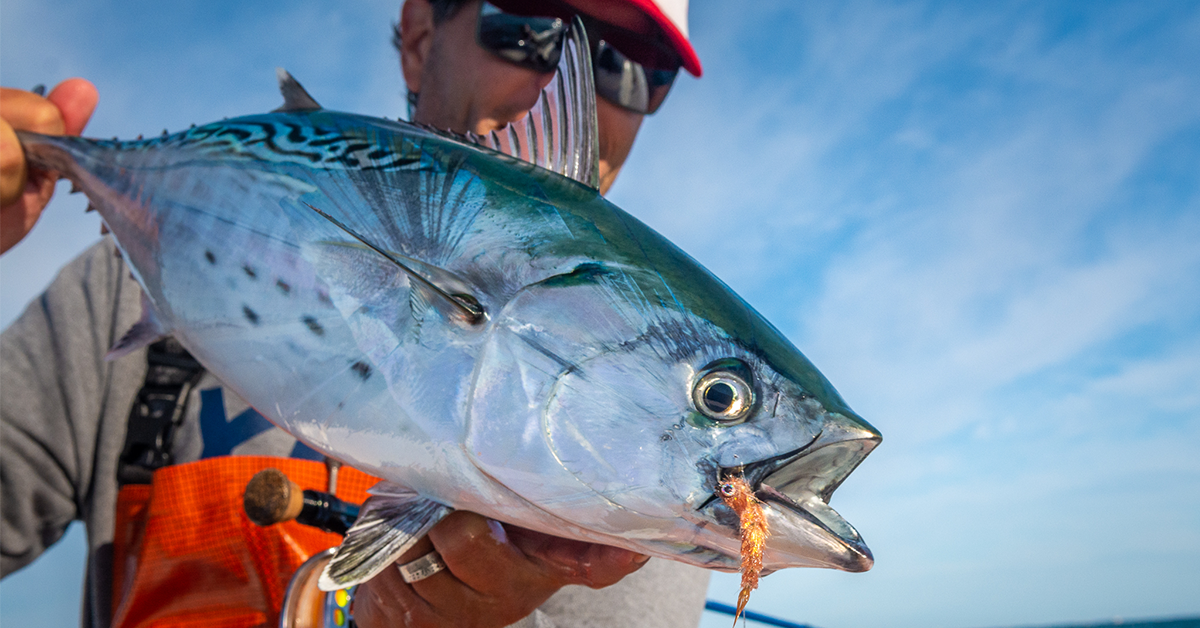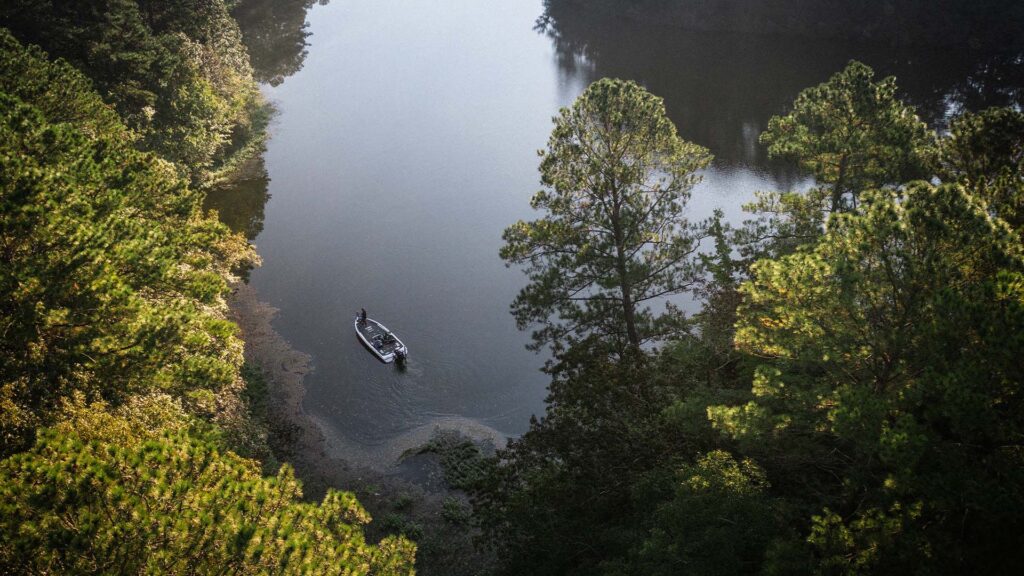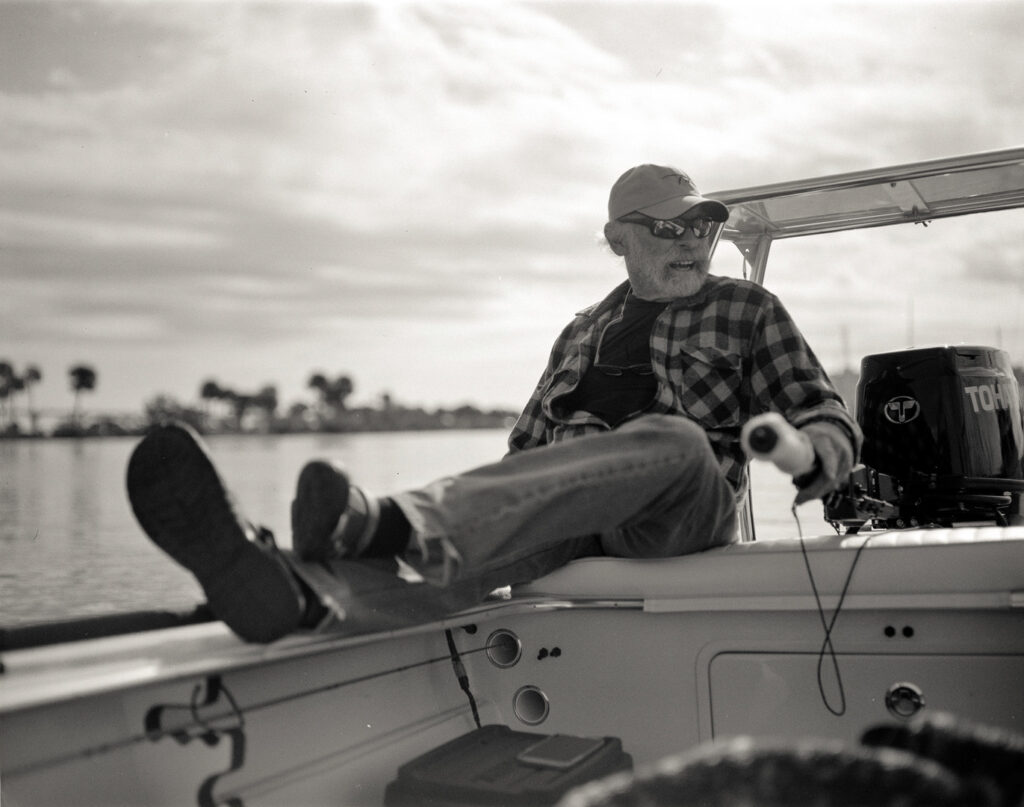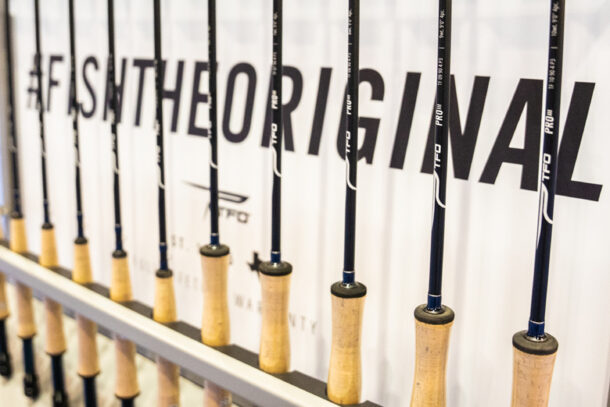While it’s easy to get sad about summer’s end, the transition into fall brings a special type of excitement to anglers on the East coast. The tail end of summer brings bull redfish inland to spawn and forage on baitfish, but by late September, a cool north wind blows offshore forcing baitfish back towards the ocean, while also bringing false albacore inland. This results in a head on collision of predator and prey, and the perfect scenario for the angler that gets at the right place at the right time.
TFO is fortunate enough to have several advisors and ambassadors with lots of knowledge and experience fishing for false albacore on both fly and conventional gear. This week, we decided to switch it up and get feedback from several of TFO’s finest – Jake Jordan, Gary Gubiel and Andy Bates – to give some tips, tactics, and insights for all things albie fishing.

TFO Ambassador Capt. Andy Bates with Fat Albert. Photo: Andy Bates
Overview, History & Migration
Give us a brief overview of false albacore. Have they always been a sport fish, and what is it about fall that makes that the time to fish for them?
Jake Jordan – False albacore (also known as Little Tunny, Albies, Fat Albert) are located in the Atlantic Ocean all the way from Maine to Chile, as well as the Gulf of Mexico, Pacific Ocean, and the Indian Ocean. Although they are in the tuna family, their rough flesh makes for not so good eating, but a fantastic sporting fish.
North Carolina was one of the first places that people started fishing them as a sport fishing fly fishing in the late 1990s. Historically, albies were referred to as a baitfish. We used to catch them, cut out their bellies, and troll them for marlin. As a sport fish, they are like any other tuna or jack – they are very, very powerful. Anglers often refer to bonefish as being one of the strongest fighting fish. An equal size false albacore is much faster and much more powerful than the same weight bonefish.
In the summer months, the baitfish (anchovies, silver sides, spearing, etc.) in the estuaries will eat and get bigger in the warmer, shallower water of the Sounds. As soon as the first cold front of the year comes through, a Northern wind cools down the surface water in the Sounds, causing the baitfish to run out of the inland water towards the warmer water of the ocean. Likewise, as soon as the albacore out in the Gulf Stream feel that cool, north breeze, they immediately swim into the wind and head inshore. They’ll come towards the beach, coming right up into these giant schools of baitfish. At this point, you can find albies anywhere from 2ft to 100ft deep.

Signs of a Bait ball – Baitfish & Birds. Photo: Colorblind Media/Rob Fordyce
Baitball, Birds, and Shrimp Trawlers
TFO: Aside from being able to see them near the surface, how do you locate albies?
Jake Jordan: Two of the most important factors in locating albies are bait balls and birds. Typically when I’m starting out for the day, even before first light, I’m just looking for bird action. Really good anglers will have “Bird Radar” where you can see out as far as 20-25 miles, but even at 10 miles, you’ll see the birds diving down on the fish and you can run right up to them. This will be a sign of either redfish or Spinner sharks, or it’s going to be albacore. Earlier in September it could even be big Spanish mackerel and King mackerel.
You’ll see these giant baitballs where the water is boiling with fish going crazy and baitfish jumping out of the water. These bait balls can be the size of a big swimming pool. All you have to do is drop your bait or fly into that boil, and before you get a chance to strip or anything, your line just takes off with a fish on the end.
TFO: Let’s say you’ve located some fish busting on a bait ball. How are you positioning yourself to cast?
Jake Jordan: Albies are unique in that they swim and feed into the wind. When you’re chasing these fish, if you can get upwind in front of the schools, you can sit there and wait for them to come right to you. I try to sit the boat right to the side but in front of the path of the schools. You’ll be casting straight into where they’re going to be, your fly is coming across the school, so basically you are casting ahead and perpendicular to them.
TFO: Do you ever spook the schools when casting to them as they are migrating?
Jake Jordan: No. These fish aren’t afraid of anything. There are times when they are boat-shy. When you get 100 f.t from them, they go down and disappear, and then they’ll pop up 300 ft from you.

On the hunt, and looking for signs of albies. Photo: Colorblind Media/Rob Fordyce
TFO: I’ve heard that fishing behind shrimp boats trawling bottom can be another great way to catch albies. Can you talk about that?
Jake Jordan: If there aren’t a lot of bait balls happening, and we aren’t seeing any birds, another way to catch albacore is fishing behind shrimp boats. Here in North Carolina, shrimp boats are operating almost 24hrs a day. Here we have flat sandy bottoms, and these shrimp boats are trolling the bottoms with these big chains holding the bottom of these large nets, just scooping up shrimp and all kinds of baitfish. About 50-60% of what they bring up to the boat is baitfish also called bycatch, the other 40-50% is shrimp. When they make their pull up to the boat, they’ll throw everything back overboard that isn’t shrimp. This will draw sharks, albacore, and millions of birds.
You can get about a hundred feet from the back of the boat and wait for the boats to throw the bycatch overboard. You can use a 10wt in this scenario (sharks), but I like to use a Bluewater SG Medium with a Power Reel using about 500-700 grain head with 1.5-2 ft of 20lb leader with about a 5 inch white Clouser minnow. I’ll set the drag on my reel to about 6 pounds. As soon as you get a hook up, I usually put the boat in reverse to get away from the boat so the fish don’t get wrapped up in the trolling nets/cables.

The man himself. Sir Jake Jordan with another albie. Photo: Jake Jordan
Fly Rods & Reels
Jake Jordan: – At the start of the season in September, and in the summer when I’m also targeting Spanish mackerel, I’ll start off with a 9’ 7wt Axiom ll-X. I’ll pair this up with a BVK SD-lll reel. Typically, you’ll want a reel with a heavy drag system, but with early season albies (4-6 pounds), you’ll be fine with the BVK-SD, and it’s a lot of fun on a 7wt. Once we start catching albies more consistently, I’ll switch over to a 9wt Axiom ll-X. I’ll fish this until late October/early November, and then I’ll step up to a 10wt Axiom ll-X. The purpose of stepping up to the 9 and 10 is relative to how the fish are growing over the season and also the size of the flies as well. I’ll pair both the 9wt and 10wt with the TFO Power III Reel.
Gary Dubiel: Im targeting albies in mid- October after the bull reds are done doing their thing inland. 9wt &10wt Axiom ll-Xs are my preferred rods. A lot of the albacore we get in coastal North Carolina are pretty big – around 16-18 pounds. The 9wt Axiom ll-X is a fabulous rod to use for albacore, but for folks that have trouble making longer casts in stronger winds, the 10wt is an excellent choice. More than anything else, you’ll want a quality reel with a great drag system, so the Power Reel III.

The Axiom ll-X & Power Reel are the perfect combo for catching and fighting albies on the fly. Photo: Colorblind Media/Rob Fordyce
Fly Lines & Leaders
Gary Dubiel: I like intermediate or intermediate tip lines – particularly a clear tip line. The reason I like that is, you’re going to do much better with direct contact to the fly. Even if the fish aren’t on the surface, if you can get the fly down to the fish a little quicker so that it get 3-6 inches down quickly. Even if you’re using a weighted fly – you’re going to do well with that intermediate line. You can also decrease your leader length to get it down quicker. For leaders, I do a 4ft piece of 20lb fluorocarbon straight to the fly.
Flies & Retrieval Patterns
Gary Dubiel: For flies, a #1 or #2 size hook that is no more than 2.5”-3” long that are fairly translucent all work well. Clouser Minnows, Surf Candies are great patterns. I like flies to have some motion, so I actually tie most of my flies with craft fur so when that flies is sinking it has a little bit of undulation to it.
Retrieves – I like to fish albacore a little bit different. When I’m striping the rod in, I don’t want to strip in really fast. Once you get in a bait ball, you want to maximize the time that the fly is in front of the fish. Just strip it enough to keep the fly line tight, and the fish are more than happy to eat it. The intermediate line lets you have more direct contact so you don’t have to do as much on the strip strike to get good hook penetration on the fish. So that intermediate line serves multiple purposes for me.
Andy Bates: I throw a lot of Clousers. I stick with mostly white, but white with tan, and white with chartreuse works too. Just depends on the clarity of the water on that day. You can catch pretty much anything in North Carolina on a white and chartreuse Clouser.

Come prepared with box of varied clousers when pursing albies on the fly. Photo: Andy Bates
Conventional Gear & Retrieval Techniques
Gary Dubiel: I use the Inshore 7’ Medium and Medium Heavy depending on what we’re throwing. Certainly for long distance casting with small, long 3” spoons whether that be mostly metal spoons, but big profile spoons about an ounce and about 3 inches long are ideal for getting really long casts to breaking fish. You can throw those and crank them fast. They can be very effective if you’re having a hard time getting on the bait balls and you’re seeing breaking fish.
If you’re on bait balls, I prefer to go to the 7’ Medium Inshore and fish soft plastics – particularly fluke style baits. Whether that be on a jig head or just a hook. Jig heads in a 1/4 -3/8 ounce aren’t going to get as far, but I find them really effective. Fishing them is very different. I use a lot of rod tip and not as fast of a reel so the bait has a tendency to dart side-to-side. You’re keeping the soft plastic in the bait longer, but giving it a very erratic speed while doing that, which seems to be very deadly effective on the fish.
Certainly 20lb braid, then 20-30lb fluorocarbon if there’s Spanish mackerel around. Definitely using 30lb when those mackerel are around.

Inshores at the ready. Photo: Andiamo Outdoor Co.
Andy Bates: A lot of people think that albies be a nuisance, and an easy fish to catch, but that’s not always the case. Its not as easy as dropping your fly or a bait in a bait ball and they’ll just crush it. Sometimes you have to get creative. When they’re feeding on really small fry, or what we call snot bait, it’s hard to match the hatch. Even if you can match the hatch, the albies almost turn into a predatory fish into a filter feeder type fish. If you’re spin rod fishing for them and you’re having trouble getting a bite, you can go to a big 5” fluke or an albie snack on a swim bait hook (weighted or unweighted) where you can make a long cast on a Medium or Medium Light rod with 10-12lb braid. After you make a long cast from a ways back, hold your tip up and rip it back as fast as you can and work the bait. You’re basically skipping the bait across the water and getting a reaction bite. I’ve found this technique very effective for when they get picky on the subsurface bite.
Fighting Albies and the Release/Launch
Gary Dubiel: When you’ve got an albie on, making sure you’re utilizing the bottom third of the rod and using the drag on your reel correctly is definitely important when playing these fish. I use a little bit stiffer drag to help slow the fish down. They’re going to go and there’s not much to do to stop them, so you let them go when they go.
Big albacore sometimes will do what’s called the death spiral, where they go straight down and spin in a circle. That can be a challenge, but a really short pump of the rod to try and pull the fish and get his head up can help prevent them from spiraling back down. You’re basically shortening the line, and shortening the line until you get him high enough in the water column to grab and boat him.
Jake Jordan: Once you catch your first fish, their tail is like a handle. Like a tuna fish, you grab them by the tail, hold them up over the boat. They’re probably going to spit out about 50 bait fish on the deck, then you get the fly and let them go. Unlike trout or other fish where you typically hold them long, albies are the opposite. When you release them, shoot them in the water like a bullet. You do this because they are so powerful and fast, they need that water going over their gills. That splash gives them a really good start. Their tail is moving when you let go of them, and they just propel themselves to get that first burst of oxygen.

Photo: Jim Shulin
If you’d like to learn and see more about albie fishing in coastal North Carolina, you might enjoy this film featuring TFO Advisor Rob “The Seahunter” Fordyce and TFO Ambassador Chris Thompson. This film was shot after the annual Cape Lookout Albacore Festival last year. Sadly, this year’s festival has been cancelled due to the pandemic, but the festival plans to resume in 2021. You can find out more about Albie Fest here.
https://www.youtube.com/watch?v=oZMwSvSE5_8&t=859s
Jake Jordan is a TFO National Advisor that has spent more than half a century guiding tarpon anglers in the Keys. During his lifetime, Jake has caught more than 2,400 billfish on the fly – thus was the perfect person to help us design our offshore rod – the Bluewater SG. Nowadays, Jake splits his time chasing tarpon in the Keys and albacores and redfish in coastal North Carolina. You can find out more about Jake here.
Gary Dubiel has been a TFO National Advisor since 2002. He currently lives in guides in the coastal North Carolina Outer Banks area through his guiding business Spec Fever Guide Service. You can find out more about Gary here.
Andy Bates has been an ambassador for TFO since 2017. He currently lives in guides in the coastal North Carolina Outer Banks area through his guiding business, Captain Bates Guiding Service. You can find out more about Andy here.
![]()







